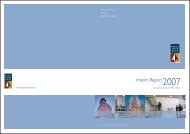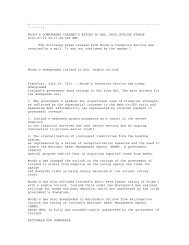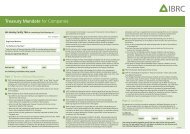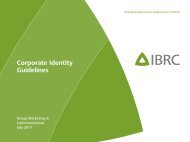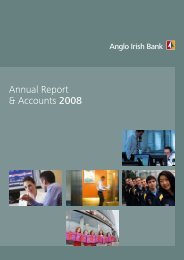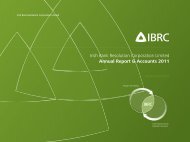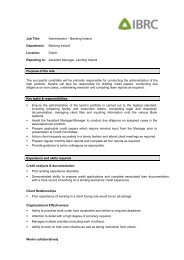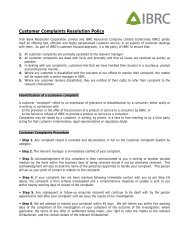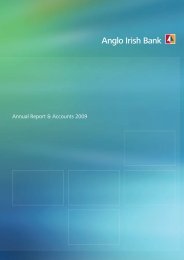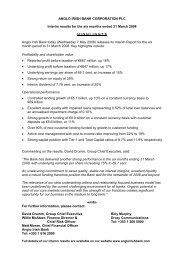IBRC annual report for 2011 - Irish Bank Resolution Corporation ...
IBRC annual report for 2011 - Irish Bank Resolution Corporation ...
IBRC annual report for 2011 - Irish Bank Resolution Corporation ...
You also want an ePaper? Increase the reach of your titles
YUMPU automatically turns print PDFs into web optimized ePapers that Google loves.
<strong>Irish</strong> <strong>Bank</strong> <strong>Resolution</strong> <strong>Corporation</strong> LimitedAnnual Report & Accounts <strong>2011</strong>PoliciesThe <strong>Bank</strong>'s Group Treasury Policy prescribes valuation models and risk measurement methodologies that ensure closemonitoring and clear <strong>report</strong>ing of all trading book risks.The primary trading book market risk measure is a Value at Risk ('VaR') model that is based on a historical simulationmethodology. It is implemented using a 99% confidence level, a 1 day holding period and two years of historic data. Thestandard risk factors capture the risks in interest rates, exchange rates, option sensitivities and interest basis. The methodologytakes into account inter-relationships between different market variables, <strong>for</strong> instance between interest rates and <strong>for</strong>eignexchange rates, and captures the risks associated with option positions in interest rate and <strong>for</strong>eign exchange instruments.Although an important and industry standard measure of risk, VaR has its limitations as a result of its use of historical data,frequency of calculation and holding periods. Additionally, the use of confidence intervals does not give any in<strong>for</strong>mation aboutpotential losses when the confidence level is exceeded. For these reasons, the Group also uses a variety of other methodologiesin measuring market risk. These include, but are not limited to, stress testing and sensitivity analysis.Reporting and measurement systemsGroup Risk provides daily <strong>report</strong>ing of trading book risk positions against all approved VaR, Present Value of a Basis Point('PVBP'), option sensitivity and stop-loss limits. It provides monthly <strong>report</strong>ing to ALCO on trading book activity with analysis ofall significant risk positions, including stress testing of positions against a range of extreme market scenarios. There is alsomonthly <strong>report</strong>ing to the Risk and Compliance Committee on compliance with risk limits.Risk mitigationThe Group Treasury Policy outlines a rigorous control environment that includes prescribing a specific range of approvedproducts. It also provides <strong>for</strong> a structure <strong>for</strong> the management of legacy trading book risk positions through a detailed set oflimits that covers all of the risk sensitivities associated with the approved products. The wind-down of the trading book involvesidentifying offsetting risk positions that can be closed out at the same time to avoid any increase in market risk positioning.The table below summarises the VaR levels of the Group’s trading book <strong>for</strong> the period using a 99% confidence level.1 Day TimeHorizon10 Day TimeHorizon<strong>2011</strong> 2010 <strong>2011</strong> 2010€m €m €m €mAt end of year 0.3 0.5 1.0 1.7Average 0.3 0.4 1.0 1.2Minimum 0.2 0.1 0.5 0.4Maximum 0.5 1.0 1.7 3.0The average and maximum VaR figures <strong>for</strong> the year ended 31 December <strong>2011</strong> were lower than <strong>for</strong> the previous period. Riskpositions were reduced during the year as the wind-down of the trading book was implemented.<strong>Bank</strong>ing book risk - interest rate riskDefinitionInterest rate risk is the risk of a potential adverse change in the Group's income or financial position arising from movements ininterest rates. It arises from the structure of the balance sheet and from the execution of customer and interbank business.<strong>Bank</strong>ing book positions are those acquired with the intention of holding them to maturity in the normal course of business.Interest rate risk in the banking book arises from a combination of lending, funding and non-trading treasury activities. TheFinancial Markets team manages the market risk associated with all of these activities on a consolidated basis.The Group's financial assets and liabilities have interest rates that are reset at different times or under different bases. There is apotential impact on earnings and value that could occur when liabilities cannot be repriced as quickly as assets in a fallinginterest rate environment or when assets cannot be repriced as quickly as liabilities in an environment of rising rates.At 31 December <strong>2011</strong>, the Group held <strong>Irish</strong> Government promissory notes with a total principal value of €28.5bn. As thepromissory notes are fixed rate instruments which create significant interest rate risk exposure, which in turn leads to potentialearnings volatility, the <strong>Bank</strong> has hedged a portion of the exposure. The <strong>Bank</strong> has hedged a total of €4.3bn of the notes usingamortising interest rate swaps, and a further €5.7bn of economic hedges exist in the <strong>for</strong>m of the Group’s capital and fixed ratedebt issuance. However, significant fixed rate exposure remains, with limited capacity to hedge further amounts with marketcounterparties. Further details on the promissory notes are set out in note 25.127



